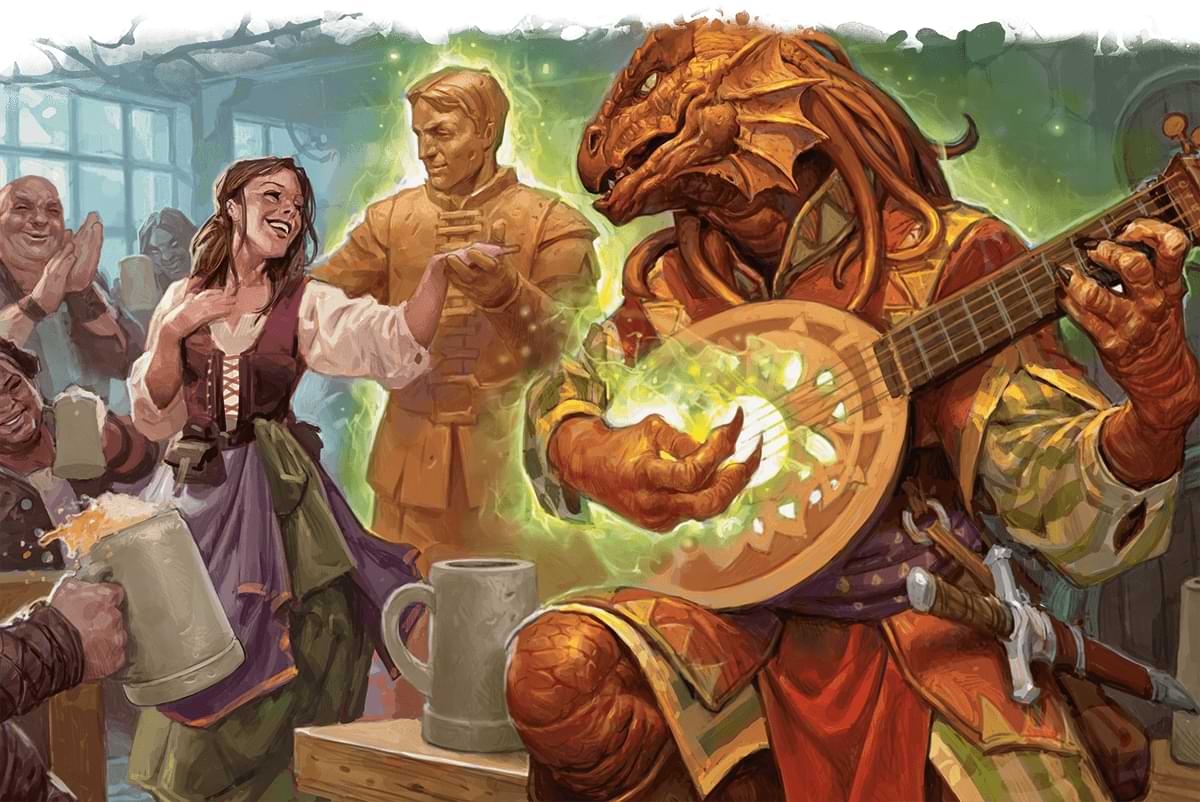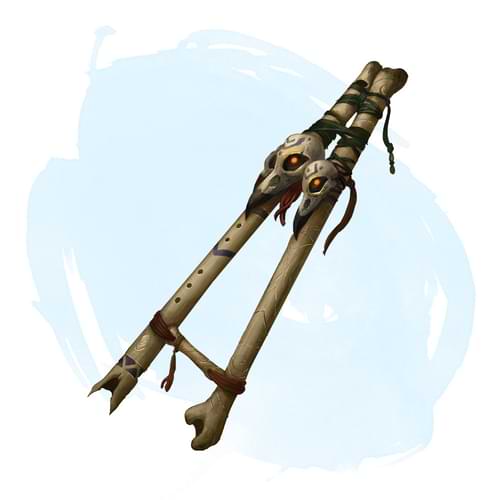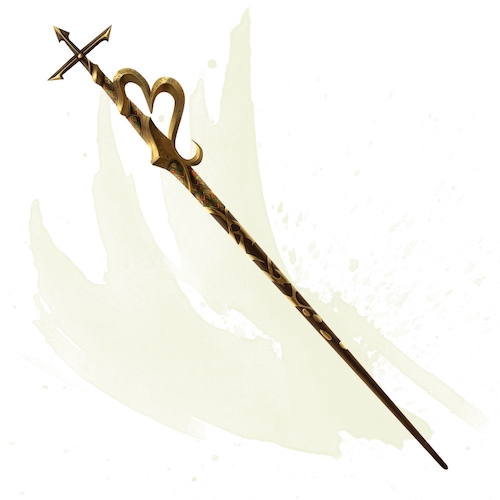Whether your bard is singing, dancing, or acting their way to fame, they can benefit from a good prop. The bard’s greatest strength lies in their versatility, and there's likely an item—probably an instrument—that can help you cover gaps in your skillset.
In this article, we list 10 of our favorite magic items for the bard class. Magic items you don’t own can be bought from the D&D Beyond marketplace or shared by someone with a Master-tier subscription.
- Ghost step tattoo
- Glamoured studded leather
- Gloves of thievery
- Hat of disguise
- Instrument of the bards
- Pipes of haunting
- Reveler's concertina
- Rhythm-maker's drum
- Staff of charming
- Staff of healing
Talk to your DM about magic items
These magic items may not be available in your campaign. Discuss your interest in magic items with your Dungeon Master, but keep in mind that some items might not make sense for your campaign setting. At the end of the day, it's up to your DM whether or not a certain magic item appears in your game.
Top 10 magic items for bards

1. Ghost step tattoo
Wondrous Item (tattoo), very rare (requires attunement)
We’re starting off strong with this list, opening with one of the most powerful magic tattoos out of Tasha’s Cauldron of Everything. In a high-intrigue or heist-laden campaign, your bard could make great use of the ghost step tattoo’s Ghostly Form ability to move through walls, even just for a quick peek. Answer the inevitable question of “Is that door trapped?” by sticking your head through to glance at the other side.
But the tattoo’s applications aren’t limited to subterfuge and reconnaissance. If you have to Dash your way through a crowd of enemies, you’ll appreciate the Ghostly Form’s resistance to nonmagical bludgeoning, piercing, and slashing damage and temporary immunity to being grappled or restrained.
2. Glamoured studded leather
Armor (studded leather), rare
If you find it available, glamoured studded leather is difficult to pass up. The armor’s magical enchantment provides a +1 to AC, and it can assume an illusory form of your choosing.
The glamour’s applications are nearly limitless. Appear as an unarmored, humble busker while you keep an eye out for a person of interest. Assume the finery necessary to crash a fancy gala without needing to prepare. Impersonate a member of the enemy’s security forces. An imaginative bard could find opportunities to use this ability in almost any adventure.
3. Gloves of thievery
Wondrous Item, uncommon
Who says rogues get to have all the fun? Sure, they’ve got the stealth and the shadows, but sometimes you need to hide in plain sight. Few would suspect the performer meandering through the crowd of being an expert pickpocket.
The gloves of thievery are invisible while worn and grant a +5 to Sleight of Hand checks and Dexterity checks made to pick locks. That “steal the evil wizard’s wand during the parade” idea suddenly seems much more possible, particularly if you have glamoured studded leather armor or a hat of disguise to help you get close.
4. Hat of disguise
Wondrous Item, uncommon (requires attunement)
One of my favorite items on this list, the hat of disguise manages to be powerful while maintaining the all-important potential for silliness. This item allows you to cast the disguise self spell at will, a comical and chaotic power to give a player. The spell save DC is relatively low, but remember that NPCs need a reason to actively inspect your appearance. Just try not to let your illusory goliath’s head pass through any ceilings.
5. Instrument of the bards

Wondrous Item, varies (requires attunement by a bard)
Few items tell you right at the outset what they are and who they’re for, so you have to admire the instruments of the bards for their candor. These instruments are paragons of their kind, each boasting a base slate of spells that can be cast once per day and the ability to impose disadvantage on a target’s saving throw against being charmed.
The individual items vary widely in their rarity, spells, and instrument type. All of them can cast fly, invisibility, levitate, and protection from evil and good, plus a unique set of three to four other spells. If your bard doesn’t play any of the listed instruments or if you and your DM don’t think any of the spell lists provided are a good fit, this could be a great opportunity for your DM to homebrew something unique to your character if they are so inclined.
 6. Pipes of haunting
6. Pipes of haunting
Wondrous Item, uncommon
As a bard, you’re likely an expert at battlefield control or debuffing enemies. The pipes of haunting can either help you lean into that expertise or allow you to stay tactically flexible.
For 1 of the item’s 3 charges, you can force all creatures within 30 feet that can hear you to make a DC 15 Wisdom saving throw or be frightened of you for 1 minute. If you’re feeling generous, you can also allow nonhostile creatures to automatically succeed on the saving throw.
Remember that creatures suffering the frightened condition cannot move closer to the cause of their fear. If your party needs to secure an important item or if you want the space to heal a fallen ally, frighten the creatures near you to help lock them down.
7. Reveler's concertina
Wondrous Item, rare (requires attunement by a bard)
Alright, so maybe I had to look up what a concertina was and maybe you had to look up what a concertina was, but your bard probably didn’t. Attune to this handy little instrument and gain a +2 bonus to the spell save DC of your bard spells. In addition, once per day you can use the reveler's concertina to cast one of the bard’s most powerful spells, otto’s irresistible dance.
Like the wizard’s 8th-level maze spell, there is no save against irresistible dance’s initial application. The target must take an action on its turn to try to end the spell’s effects. In the meantime, your party has advantage on attack rolls against the target, the target cannot leave its space, and it has disadvantage on attack rolls and Dexterity saving throws. Revel, indeed.
8. Rhythm-maker's drum
Wondrous Item, varies (requires attunement by a bard)
Tasha's Cauldron of Everything introduced several items that I think of as, essentially, “the rod of the pact-keeper for other spellcasters.” These items provide a bonus to your spell attacks, a bonus to your class’ spell save DC, and an additional unique benefit. Such bonuses increase with the item’s rarity, beginning at +1 for uncommon variants and ending at +3 for very rare variants.
With the rhythm-maker’s drum, not only is your magic empowered, but you can use an action to play the drum and regain one use of your Bardic Inspiration. If your party doesn’t have time for a short rest between encounters, lay down a little beat to tide yourself over.
 9. Staff of charming
9. Staff of charming
Staff, rare (requires attunement by a bard, cleric, druid, sorcerer, warlock, or wizard)
As a bard, charming NPCs is likely already within your skillset. With the staff of charming, you can turn a hobby into an expertise. This staff allows you to cast charm person, command, and comprehend languages, a suite of spells with both combat and roleplay potential.
However, if I were a bard I would most want the staff for its unique defensive properties. Once per day, you can turn a failure against an enchantment spell (that targeted only you) into a success. Separately, whenever you succeed on a saving throw against an enchantment spell (again, that targets only you) you can use your reaction to expend 1 charge and turn the spell back on its caster as if you had cast it. I want this item for the roleplay of reflecting a command spell alone.
If you want to charm folks en masse, without requiring concentration but also without the defensive abilities of the staff of charming, look to the rod of rulership instead.
10. Staff of healing
Staff, rare (requires attunement by a bard, cleric, or druid)
Not all bards want to learn healing spells and perform the noble work of spending their action doling out hit points. If you do, and you would appreciate an extra 10 cure wounds per day, you’ll positively adore the staff of healing.
If you don’t prefer to play a healer but are happy to knit wounds in a pinch, you could also benefit from the strategic flexibility that the staff provides. Between cure wounds, lesser restoration, and mass cure wounds, you could learn all the charm and damage spells you want and still rest assured that you’re providing a massive healing boon to the party.
Let’s build a bard!
Consider your creative starting point for your bard. Do you first envision their personality, artistic career, subclass, or perhaps their voice? Whatever the answer, hop into D&D Beyond’s character builder to get started!
Damen Cook (@damen_joseph) is a lifelong fantasy reader, writer, and gamer. If he woke up tomorrow in Faerun, he would bolt through the nearest fey crossing and drink from every stream and eat fruit from every tree in the Feywild until he found that sweet, sweet wild magic.

-
View User Profile
-
Send Message
Posted Mar 3, 2022AMAZING. The bard is my favorite class and although I've heard of some of these, others are totally new. Well done! Thank you Damen Cook!
-
View User Profile
-
Send Message
Posted Mar 3, 2022I've wanted to make a bard for a while and this is really helpful
-
View User Profile
-
Send Message
Posted Mar 3, 2022wow good story over all
-
View User Profile
-
Send Message
Posted Mar 3, 2022Nice! I've never felt confident enough to play a Bard, but I do like them in 5th.
-
View User Profile
-
Send Message
Posted Mar 3, 2022YES! The Best Magic Item series is back!
-
View User Profile
-
Send Message
Posted Mar 3, 2022Which leads us to Rogue 201. The first magic items on the list are great for rogues. Makes total sense, since bards can easily serve as the rogue-replacement. They are better skill monkeys than rogues, and have magic.
-
View User Profile
-
Send Message
Posted Mar 4, 2022So, my Kobold Wizard's Apprentice wears a Hat of Disguise. It make for the most amazing and hilarious scenes. He's no bard, but I mean, Hat of Disguise, how would that not be a blast? :) And don't ask where they found the hat. That'd be incriminating.
-
View User Profile
-
Send Message
Posted Mar 4, 2022All of these are nice thoughts, but the best items for a bard are clearly the ring of shooting stars, robe of stars, and gloves of climbing!
-
View User Profile
-
Send Message
Posted Mar 4, 2022What about subclass specific items? Like what do you think would be best for a Swords or Valor Bard? Or Whispers or Spirits?
-
View User Profile
-
Send Message
Posted Mar 4, 2022I’m not really the biggest Bard fan because my first DM (my best friend) gave me an annoying singing bard that was reincarnated every time I killed him he got more annoying but the magic items really Mach up with the class. I also think when you do articles like this you should start suggesting best magic items for their subclasses as well.
-
View User Profile
-
Send Message
Posted Mar 4, 2022The Ring of Mind Shielding is a great one as well.
-
View User Profile
-
Send Message
Posted Mar 4, 2022super helpful! I hope you'll be doing this for other classes, I could use some ideas for my barbarian...
-
View User Profile
-
Send Message
Posted Mar 5, 2022For spirits (and other subclasses) - Cloak of Billowing. It doesn't do much mechanically, but darn does it look cool when used properly. It's great for that extra dramatic effect.
-
View User Profile
-
Send Message
Posted Mar 5, 2022I'd add luck stone, it takes jack of all trades and turns it to 11!
-
View User Profile
-
Send Message
Posted Mar 7, 2022I would add Flying Boots. Bards are not front line fighters although they can be very useful in combat. Having flying boots gives you the freedom of movement, to fly over hazards and to retreat more easily. They allow you to fly out of melee and charge range yet you can still taunt your opponents. They help avoid the nasty effects of falling from a great height, scout ahead from the air, access open windows at height, land on a roof with silence or invisibility and do a bit of recon or simply help put on a great performance. They are so versatile and they are merely an uncommon magic item. I've played a half-elf bard (College of Lore) and it has been one of my favourite characters to date and my experience with using flying boots means I would add this to the top of my list of useful magic items.
-
View User Profile
-
Send Message
Posted Mar 9, 2022That's a very helpful list! Thank you!
Glamoured Studded Leather and Reveler's Concertina are awesome! Oh my! I was unaware of those itens. Love it!
I'd like to have the Leather in real life. Hah
-
View User Profile
-
Send Message
Posted Mar 11, 2022A bit "on the nose", don't you think?
-
View User Profile
-
Send Message
Posted Mar 14, 2022nice
-
View User Profile
-
Send Message
Posted Dec 7, 2022What part of "pick locks" translate to picking a wizard's pocket?